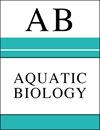Benthic assemblages in relation to planktonic assemblages in a eutrophic, thermally stratified reservoir
IF 0.8
4区 生物学
Q3 MARINE & FRESHWATER BIOLOGY
引用次数: 0
Abstract
ABSTRACT: Few studies have explored the relationship between benthic and planktonic assemblages in reservoirs, despite their role in food chains and maintaining ecological functions. Macroinvertebrates play a crucial role in food webs and contribute about 42% of whole-lake secondary productivity. Therefore, their status is vital for maintaining good ecological functions. In this study, we selected Nanwan Reservoir, a eutrophic thermally stratified reservoir in China, to evaluate the community of macroinvertebrates in different seasons and explore the relationships between macroinvertebrate assemblages and different planktonic groups, including phytoplankton, protozoans, rotifers, and planktonic crustaceans. Cyanophyta and Bacillariophyta dominated the phytoplankton assemblages, and their proportions varied with seasons. The bad community of macroinvertebrates in summer, autumn, and winter could be attributed to the excessive growth of Cyanophyta or other phytoplankton. Based on the results of partial least squares regression, an algorithm used for prediction, we determined that the excessive growth of algae, crustaceans, protozoans, and Cyanophyta was detrimental to the development of macroinvertebrates, and was indicative of high nutrient loads in the reservoir. However, the growth of Bacillariophyta, Chrysophyta, and Euglenophyta was advantageous to macroinvertebrate assemblages and indicated a better ecological condition of the reservoir. The results of partial least squares structural equation modeling demonstrated close associations between phytoplankton and both zooplankton and macroinvertebrates, indicating their interdependence in this reservoir system. Our study results imply that the status of macroinvertebrates can be predicted by the abundance of some planktonic assemblages, and cost savings from selecting one of the planktonic groups to monitor ecological conditions could be accomplished in future studies.富营养化热分层水库底栖生物群与浮游生物群的关系
摘要:尽管底栖生物和浮游生物在食物链和维持生态功能方面发挥作用,但很少有研究探讨它们之间的关系。大型无脊椎动物在食物链中扮演着重要角色,约占整个湖泊次生生产力的 42%。因此,它们的状况对维持良好的生态功能至关重要。本研究选择了中国富营养化的温层水库--南湾水库,对其不同季节的大型无脊椎动物群落进行了评价,并探讨了大型无脊椎动物群落与浮游植物、原生动物、轮虫和浮游甲壳类等不同浮游类群之间的关系。浮游植物群中以蓝藻纲和枯草纲为主,它们所占的比例随季节而变化。夏季、秋季和冬季大型无脊椎动物群落不佳的原因可能是蓝藻或其他浮游植物生长过旺。根据偏最小二乘法回归(一种用于预测的算法)的结果,我们确定藻类、甲壳类、原生动物和蓝藻的过度生长不利于大型无脊椎动物的发育,并表明水库中的营养负荷较高。然而,枯草藻类、菊石藻类和欧根藻类的生长对大型无脊椎动物群落有利,表明水库的生态条件较好。偏最小二乘结构方程模型的结果表明,浮游植物与浮游动物和大型无脊椎动物之间存在密切联系,表明它们在该水库系统中相互依存。我们的研究结果表明,大型无脊椎动物的状况可以通过一些浮游生物群的丰度来预测,在未来的研究中,选择其中一个浮游生物群来监测生态状况可以节约成本。
本文章由计算机程序翻译,如有差异,请以英文原文为准。
求助全文
约1分钟内获得全文
求助全文
来源期刊

Aquatic Biology
生物-海洋与淡水生物学
CiteScore
2.70
自引率
0.00%
发文量
7
审稿时长
3 months
期刊介绍:
AB publishes rigorously refereed and carefully selected Feature Articles, Research Articles, Reviews and Notes, as well as Comments/Reply Comments (for details see MEPS 228:1), Theme Sections, Opinion Pieces (previously called ''As I See It'') (for details consult the Guidelines for Authors) concerned with the biology, physiology, biochemistry and genetics (including the ’omics‘) of all aquatic organisms under laboratory and field conditions, and at all levels of organisation and investigation. Areas covered include:
-Biological aspects of biota: Evolution and speciation; life histories; biodiversity, biogeography and phylogeography; population genetics; biological connectedness between marine and freshwater biota; paleobiology of aquatic environments; invasive species.
-Biochemical and physiological aspects of aquatic life; synthesis and conversion of organic matter (mechanisms of auto- and heterotrophy, digestion, respiration, nutrition); thermo-, ion, osmo- and volume-regulation; stress and stress resistance; metabolism and energy budgets; non-genetic and genetic adaptation.
-Species interactions: Environment–organism and organism–organism interrelationships; predation: defenses (physical and chemical); symbioses.
-Molecular biology of aquatic life.
-Behavior: Orientation in space and time; migrations; feeding and reproductive behavior; agonistic behavior.
-Toxicology and water-quality effects on organisms; anthropogenic impacts on aquatic biota (e.g. pollution, fisheries); stream regulation and restoration.
-Theoretical biology: mathematical modelling of biological processes and species interactions.
-Methodology and equipment employed in aquatic biological research; underwater exploration and experimentation.
-Exploitation of aquatic biota: Fisheries; cultivation of aquatic organisms: use, management, protection and conservation of living aquatic resources.
-Reproduction and development in marine, brackish and freshwater organisms
 求助内容:
求助内容: 应助结果提醒方式:
应助结果提醒方式:


